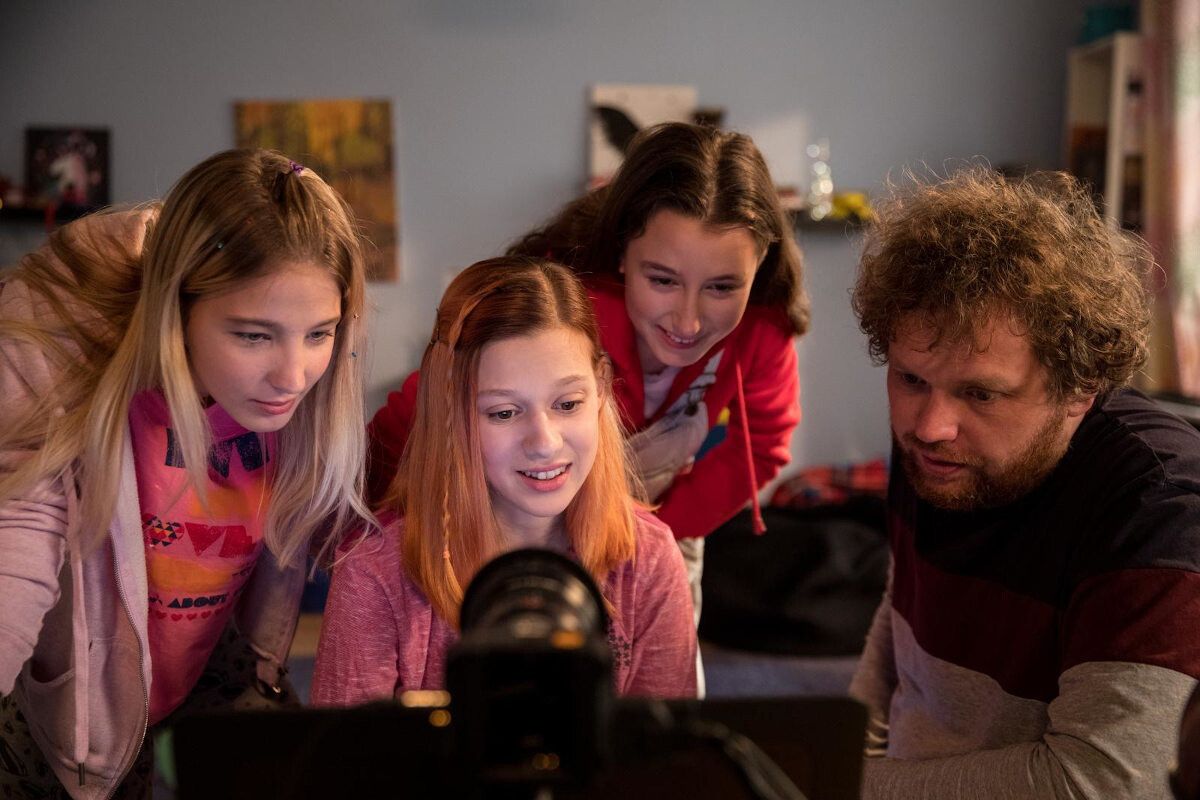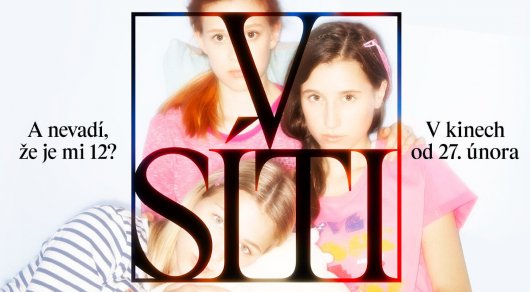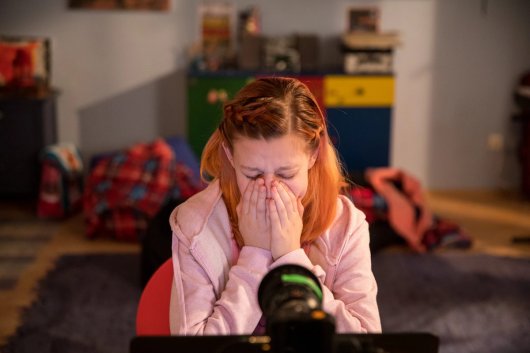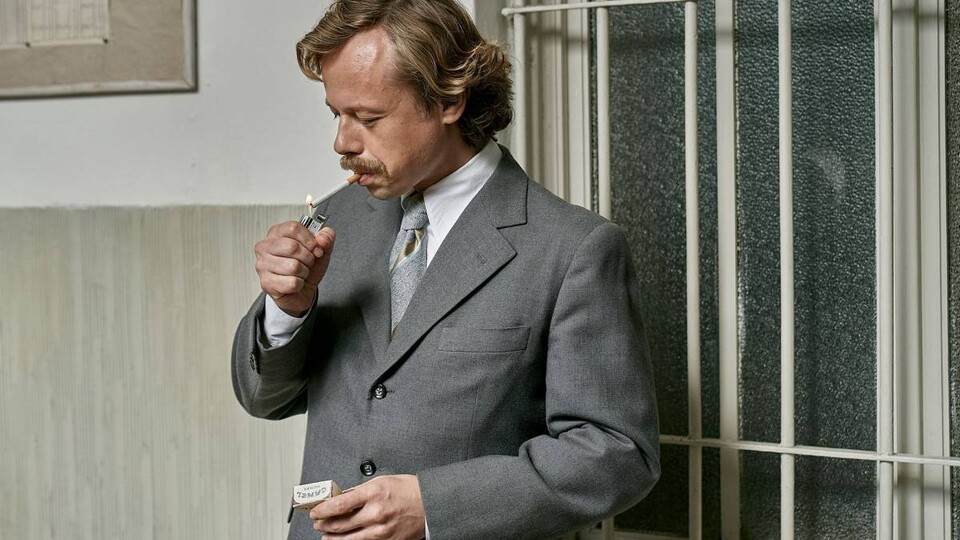Caught in the Net should really be on the net if it’s going to change anything
The new film by Vít Klusák a Barbora Chalupová Caught in the Net was discussed for dok.revue by film critic from the magazine Film a doba and contributor to the web portal A2larm Martin Šrajer (MŠ), film scholar Jan Kršňák (JK), who engages in intuitive pedagogy and works for the platform Digiděti as a “pacifier of digi-children and digi-adults” in the age of the digitalisation of society, and psychologist Hedvika Boukalová (HB), who works as a forensic psychologist, consultant, and psychotherapist (for students of FAMU, among others) and is engaged in an academic capacity in the Department of Psychology at Charles University’s Faculty of Arts, where she focuses on social psychology including issues related to criminal offenders and their motivations.
Exactly what kind of film is Caught in the Net? How would you characterise it?
JK It’s a film-event – a film which aims to change reality, to reshape it. The film drew such a massive number of people in its first weeks because it deals with themes of sex and fear for children’s safety, which are two topics that reliably get people into cinemas, so long as there’s presently no corona virus. The filmmakers also launched a massive campaign through many different media channels. Caught in the Net is successful because it’s not a documentary – it’s a multimedia film. It uses digital technologies and social networks in order to raise awareness of the problem of sexual predators on the internet. There are two versions of the film, a website, a book, screenings with discussions in cinemas, and interviews all over the media. As opposed to a typical documentary, its goal isn’t to change the perception of an issue that was previously invisible in society, but rather, if possible, to bring and end to the issue altogether.
Do you agree that it’s a film-event?
MŠ I see it as a multimedia project – the intersection of various activities converging in a film which grabs as much attention and generates as much social reaction and discussion as possible. The film itself is designed to get attention and evoke strong emotions. It’s more successful in provoking a response than in offering contextual information and raising public awareness. This aspect is instead handled by the adjacent activities which work in concert with film, such as the book or the screenings for schools. The keyword is fear. The final scene of the film is a direct warning. The camera draws back from a housing estate at night, where light shines from a single window. It’s one of few scenes in the film that works with a non-literal evocation and instead relies on us presumably imagining a predator behind the window at this very moment chatting with an underage girl. It’s as if the film is leading us into the darkness outside the controlled environment of the studio or cafés, where the filmmakers and bodyguards are always nearby. The ending contrasts with the prologue, in which we see parents with their children during the day.
The entire narrative of the film is structured so as to take us from light into darkness, which in itself has an almost fairy-tale undertone. Good versus evil. Three girls against the monsters… The film’s marketing campaign even worked with this when they released a slightly bizarre explication for the film’s poster clarifying the fairy-tale motifs of Little Red Riding Hood and a unicorn with a phallic horn.
Caught in the Net. Photo Aerofilms
Yes, that explication for the poster seemed a bit absurd. I think few people would interpret it this way.
MŠ Their explanation didn’t seem that absurd to me in the context of the film’s development. The filmmakers are presenting a nearly archetypal, very black-and-white story: on one side you have the evil men committing potentially criminal acts, and on the other you have the innocent girls – the victims. There’s very little ambivalence in most of the scenes, nor even an attempt to make the viewer think more deeply. The audience is put in a position so that they see the film from the perspective of the creator – which is why the film often cuts to the face of Vít Klusák, who shows us how we’re meant to react to the situations and interactions in the film. We should be horrified, touched, amused… One extreme example is the scene with a close-up of the face of a girl moved to tears by the single decent man on the internet – the character Lukáš. By using the filmmakers’ faces, the music, and the editing, the film puts the viewer in a clearly defined position.
JK This is all true, but Caught in the Net isn’t a film – it’s not just a narrative that brings an issue to light, like every other film. In this case the filmmakers also want to transform society. Caught in the Net aims to dissolve this issue into society through individual channels and then distil it into a real response. The film’s narrative and the viewing of it are thereby transformed into direct action – raising awareness, helping those afflicted, and an effort to eliminate unacceptable behaviour. And it was working, at least until the corona virus entered the picture.
MŠ That was definitely the filmmakers’ goal. At the same time, I try to view this film as an artistic artefact and investigate it as a particular system – to reflect on how inspires from a formal perspective. From that viewpoint, as a film critic, it doesn’t seem particularly thought-provoking.
JK Except a film is something different in the context of our digitalised society. Suddenly it’s no longer a screen with the viewer sitting opposite. The film space has exited the cinema and slipped into the hand or pocket of every child. Into their lives. Today each child is actor, cameraman, and director of their own film. It’s a part of their identity, especially during puberty, when it’s incredibly difficult to tear a child away from their mobile. This film, the internet, forms a digital network populated by you and other characters for whom you can become an object of satisfaction. The goal of Caught in the Net is simply to raise the issue, but then it’s up to us what we do with it.
But what can we even do about internet predators? How do we make it so that social network operators prevent such things from happening on their platforms? What can we do as a society so that we don’t have thousands of broken young men who are so desperate that all they can do is abuse the online image of a twelve-year-old girl? What breaks us like this? Many different factors contribute to the formation of mentally ill people lacking in self-confidence. These are the kinds of questions posed by Caught in the Net.

Caught in the Net. Photo Aerofilms
Let’s look at these factors then. What would you say is the psychological profile of the predators shown in the film?
HB It’s widely known that there’s no single type of offender. Their motivations vary. The men we had the opportunity to see in the film fall more into the category of people who lack inhibition when it comes to hurting others or children. They’re willing to use coercion and threats and even to ignore the needs of others and disregard whether their actions can cause harm. Many of them, at least in my interpretation, took a relatively quick and direct path toward their own sexual satisfaction. This is not typical for all types of offenders who enter into contact with children. Some want to maintain contact and don’t want to harm the children, although they still use them in some way for themselves and for their own needs. However, they don’t proceed so directly with no regard for what it does to the child. I got the feeling from this documentary that these are people who have limited empathy and consideration for others and are focused on their own needs. It was clear from the personal confrontation with one of the offenders how this person deals with the guilt, how he blames the girl’s parents for not raising her properly. There are various strategies an offender uses to shift the blame. Understanding how one can harm a child through the use of coercion is an important part of working with offenders.
Doesn’t this lack of empathy stem from the fact that the communication plays out on an anonymous platform?
JK It’s interesting that it’s often not anonymous. The predators in the documentary usually used their real names and only a few of them felt the need to hide. In my work I deal with the influence of technology on human life. Technology is real, and this communication is real. Which is why it can lead to real sexual assault or to another situation which, thanks to this film, we can now talk about – whatever that may be. Our society is becoming digitalised and this brings a host of changes with it. Among them is a loss of empathy that comes with new types of communication and relationships.
Isn’t that precisely the problem? This type of internet communication and social networking which distance us from each other? It’s not the same as in real life, as we saw in the film during the confrontations between the girls and the predators in the café…
JK The lack of empathy is, among other things, a consequence of pornography. When watching porn, the viewer isn’t interested in the actress’ personality. He doesn’t form any kind of personal relationship with her. She’s merely a means to satisfy his needs. For predators, a social network is like a genre of pornography, and unfortunately, it’s more practicable with twelve-year-old girls than with twenty-five-year-old women. That’s why this empathy is missing.
Caught in the Net. Photo Aerofilms
Do you get the feeling that for these people the line between fiction and reality – or more specifically the line between porn and live chatting – sometimes becomes blurred?
JK Based on what the filmmakers and experts involved in the film say, the vast majority of these predators aren’t sexual deviants. They’re people who have overdosed on pornography. Porn works like a drug – you constantly need stronger and stronger doses, and after a certain point, it loses its effect. For these people, a social network like Lide.cz is like just another porn site. This is precisely what we see in the film when one of the guys has a party at his flat, but he locks himself in the bathroom so he can chat with a twelve-year-old girl.
HB I would add that this requires a person to have a kind of predisposition in their character. Many people have no problem distinguishing between what is pornography or consensual erotic communication and what is not. Personality plays a large role in this. Many consumers of pornography would feel inhibited from doing something like we see in the film, even though they might be attracted to the girl. Which is why I believe that the majority of the predators in the film are predisposed not to feel this inhibition. It’s said that in criminal acts committed against children, paedophilia plays a smaller role than the personality of the offender and their lack of regard for the feelings of others. However, it’s interesting that when I work with digital recordings from investigations, which usually show interactions between police and the person being investigated, these recordings have a very strong effect on people, even though they’re far less graphic than many films today. This shows that in many cases people psychologically distinguish between digital reality and real life – for example they view violent scenes in films with detachment, whereas authentic situations from an investigation have a much stronger impact.
JK This relates to the popularity of true crime series, which strive to be as realistic as possible. It shows how difficult it is to maintain the viewer’s classic critical detachment in which cinematographic techniques remind us, “here’s the picture, which has a specific frame, which ends here, and that’s where ‘I’ begin.” But people’s experiences in cyberspace show that this subject-object paradigm is definitively crumbling. It’s no longer possible to see the self as something separate, self-sufficient, and independent from the exterior. It’s no longer clear where the viewer ends and the picture begins. This can be seen in the situation you just described. All of Western philosophy from the past five hundred years is based on the individual, but we’re living in an age when the individual is beginning to dissolve into new forms. Caught in the Net finds that this dissolution can be hurtful. What does a child who lives through this feel? What mark does it leave on them?
HB This is very individual, depending on what each girl goes on the internet to find. Some desire communication, and others adulation, and there’s nothing wrong with that. According to expert studies, there is a growing sentiment of loneliness among people, and what they supposedly miss the most is deeper, meaningful daily conversation.
Caught in the Net. Photo Aerofilms
That’s an interesting question – what are children are looking for on these chat sites? The film doesn’t consider this perspective, as they used hired actresses and their aim was to catch predators. It doesn’t problematise mutual communication between predators and children, even though children in some sense meet the predators halfway by setting up their profiles and keeping up the conversation.
HB It seems important to mention in this context that even children have sexuality, and they’re not always simply seeking a friend for conversation. Many parents probably find this hard to accept because it’s unpleasant for them to think about. However, children get curious, and then when they start chatting with strangers, they often have experiences that more likely frighten them.
JK The internet was invented for communication with strangers. We all communicate through the internet, and children see this as the usual state of affairs. Research has shown that only one third of children have unpleasant feelings when they come across sexual content on the internet. Forty percent of children have no problem with it, and the rest enjoy it. The problem with this research is that it was performed on children from 9 to 16 years old, which includes teenagers. Supposedly only 14 to 17 percent of children are extremely upset when they come into contact with some kind of sexual content. And that doesn’t mean we’re talking about direct trauma or abuse. Perhaps they simply receive an unsolicited message from a friend. These numbers don’t imply that whenever a child finds sexual content on the internet that they have a breakdown and have been assaulted. However, Caught in the Net gives that impression. Then parents see it, and they’re even more terrified. And conversely, it fails to connect with parents from underprivileged and excluded families, who are the ones who need to see it most.
That could be where the version Caught in the Net: School’s Out comes in, made for children twelve and over and meant for school screenings with discussions...
JK I saw that version. I think it’s important that the ten commandments of internet safety that the actresses recite in the film were put on YouTube. Caught in the Net should really be on the net if it’s going to change anything. The problem with the school version is that it’s not intended directly for schools, but instead the schools are meant to attend screenings in cinemas with accompanying discussions with the filmmakers or experts. This really limits the number of children who will see the film because I doubt that children from small-town schools will ever get the chance. Moreover, when ten classes go to the cinema for a screening and one of the children ends up reliving some past trauma, it will be difficult for them to open up and confide in someone in that environment. That’s not the place for it, and it would more likely require psychotherapy sessions with a professional.
HB There are efforts to incorporate school psychologists and prevention methodology specialists in the screenings, which is the right way to go. A psychologist has the opportunity for individual sessions and can direct children and their parents toward further systemic therapy.
JK The problem is that far from all schools have these kinds of professionals, and in the Czech school system this role is given no priority. It’s a problem right now at an institutional level, but perhaps that will change thanks to this film and thanks to the fact that people are now speaking about these issues. The Czech system doesn’t facilitate the development of trust between teachers and children. There’s no time, space, nor even will for it. Not even on the side of the teachers. We have to tell ourselves that this is more important than, say, learning about chemistry or the Habsburgs’ ascension to the Czech throne. The amount of suicides among children is not an insignificant number...
Caught in the Net. Photo Aerofilms
Let’s get back to the film, which could have one positive effect in that it is instructional, in a good way. Children could now also start hunting these predators like the filmmakers – for example by saving pictures of a predator’s private parts and using them to extort him.
JK Some YouTube channels even troll predators, for example the channel King of Souls, which one young girl has been running since 2018. Once in a while she publishes a video about how she writes back and forth with guys who want her photos. She just keeps sending them pictures of graveyards until they give up. YouTubers have different genres of videos, and trolling sexual predators is bound to become a new one that will be popular for a while. YouTubers want to help. Of course, most of them don’t follow the rulebook about how to talk to a predator like they did in Caught in the Net. These rules are important. Without them these YouTubers could end up provoking the predators even more. But children will take advantage of that. And the film is unfortunately also instructional in a negative sense. It tells children that they should never send anyone their nude photos, even if someone offers them money, from which some kids might infer that they can get money for their pictures and then try it.
HB Some children actually start distributing pornography once they reach the legal minimum age and realize that there’s a market for it.
Parents could play an important role in this as well. The film could open their eyes to the dangers their children can face on the internet, and they could speak with their kids about it...
JK Unfortunately, for most parents the film only evokes fear. From a parent’s perspective it’s hard not to identify with the characters and situations in the film and personalise them. You feel afraid, and you want to protect your own children. Fear creates the feeling in a parent that they have to do something about this situation, and they start trying to control their children. But you can’t protect your children on the internet by controlling them. It’s better to build trust. You can’t prevent something like this from happening to your children, but you can help them to feel like they can confide in you about it. You can tell your children that this is a problem on the internet, and that it can happen to them too, and that if it does, and it makes them feel bad, they should come to you. Then you can deal with it, stop the predator, and take care of the child’s mental state. But your children won’t come to you if you’ve tried to control them for their entire childhood and prevented them from using social networks or criticised what they do on the internet. That destroys your mutual trust. Your children think you don’t care about what they do on the internet.
Building trust in a relationship begins when the child is around seven years old because in puberty it’s already too late. Then a parent is the least likely person a child will come to. Which is why we have to take an interest in what our children do on the internet. Take an interest, but don’t control and don’t judge. If I come to my child, terrified by what I saw in Caught in the Net, and dump all that fear onto him, then if something does happen to him, he’ll be afraid to come to me because he doesn’t want to stir up all that fear in me again. Luckily, the film is well-made – and funny – so we don’t come out feeling completely hopeless. The creators managed to make it so that it’s not a horror film. It’s perhaps as human and level-headed as it can be, given the subject matter.
That’s a good observation. While the film points out the problem, it doesn’t devastate the viewer. It’s watchable – and mainly because it’s “make-believe”. These aren’t real children it’s happening to. They’re adult actresses. It’s a social experiment, a trap for predators. The girls’ bodyguard is always in sight, the glimpses we see of the filmmakers break the illusion that this is real. Which is why I had the feeling the girls were completely safe. If these were authentic materials, the viewer probably wouldn’t be able to stomach it. Do you agree?
MŠ This film “make-believe” provides the viewer with a certain relief, thanks to which the film is bearable. Some funny moments even make it easy to watch, which is paradoxical considering the theme. The viewer isn’t disturbed by what they see because they’re used to narrative film techniques, and this film works in a similar way. I respect that this was the filmmakers’ intent, and that it would be unwise to try to make this film more experimental or suggestive like the other films of Vít Klusák, which I think in this regard were more risqué and ambiguous with no clear answers to the questions they posed. In Caught in the Net it’s always clear why Klusák turns the camera on himself, what his goal is in doing so, where he wants to lead us.
Caught in the Net. Photo Aerofilms
JK I think the reason we often see the crew’s reactions is because the issue is staged on a set that’s opened outward from the film. You’re still looking at it as the closed, 100-minute story taking place on the screen. But that’s not the case with this film. It’s playing out even now. We’re in the film! Vít Klusák isn’t the centre of it – he’s merely excavating the issue. And after that he needs hundreds of other people who will continue doing field work on it. The socio-psychological background of this problem is so vast, that it can’t be worked out in the scope of one film, and it wouldn’t even make sense to do so. Because we’re living in the diegetic space of this film – cyberspace. And it’s not bound by a screen.
It has no frame.
JK Yes, this film is all around us and inside every one of us. One of the big questions of the day is how to insert children into this “non-frame” and “non-space” in a healthy way. We have to address the big questions – what is an individual, or what is a society based on individuality which is breaking down more and more into units that are incapable of communication, empathy, compassion, or considering the views of another? We’re so broken that we no longer know who we are.
HB I often see that a person’s loss of confidence arises in early childhood, based on their primary relationships. As long as the parents or caregivers create positive feelings in a child – that they like him and that he can like himself, then he won’t be so unsure of himself later in life.
JK That’s key! We don’t feel accepted, even by those closest to us. We also live in an individualised society, and parents don’t have time for their children. What’s more, parents don’t let their children go outside because it’s dangerous. Because we as a society have created a world so dangerous that we’re afraid to let our own children out into it. So they sit at home. They’re on the internet, which we also restrict, limiting their opportunities to communicate with their friends...
HB In many places, outside isn’t the same as it once was. Children used to play outside all afternoon, but today the urbanist design of cities doesn’t encourage it.
Cyberspace is becoming our primary space. And we adults are even more addicted to it than our children...
JK That’s called the digitalisation of society. I start my lectures by saying that the word “children” in the title of the seminar is just a marketing hook, and it’s actually about parents and technology.
Mr. Šrajer, in your review of Caught in the Net for A2larm you claim that “the film misses the heart of the problem”. Now, after this debate, would you amend anything in your critique?
MŠ Certainly many important things related to the theme of the film were brought up here, but my view is still the same – perhaps limited by a neo-formalist approach in which I view a film primarily as a closed artefact and investigate its effect on the viewer. It’s not a bad film. It accomplished what the filmmakers outlined within the scope of the given concept. But from this perspective, one could take issue with how inorganically the film mixes various documentary modes – for example, we may see some experts explaining information to us, but then it shifts to a striking reflexive mode, an attempt to arouse strong emotions. Switching between various approaches like this hurts the narrative dynamic.
JK What, in your view, is the heart of the problem that the film misses?
Caught in the Net. Photo Aerofilms
MŠ The broader social context from which the problem stems. The way the film portrays sexual predators doesn’t take into consideration what kind of people they are or the environment they live in that leads them to behave in this way. It could be due to the social mindset toward which men are driven today, which teaches them how they’re supposed to behave toward people who are in a submissive role, and in that case, an abuseable position – which doesn’t necessarily mean only women. This isn’t a problem only of sexual predators. They’re just a radical expression of a wider problem, which has deeper roots and to some extent concerns our entire society, which is something the film doesn’t factor in. It’s not just about children and communication on the internet. It’s about the culture that surrounds us – media, advertisements, schools – everything that supports the given mindset. The film merely gestures at this context, and its absence, for example, leads many viewers to see these predators in the film as paedophiles – just take a look at the comments about the film on Facebook or the Czechoslovak Film Database. And that’s despite the fact that the film clearly states that these aren’t paedophiles. The film is successful in eliciting fear of the behaviour of a certain group of people, but it doesn’t force us to consider the more far-reaching connections, and it ignores that we all carry a share of the responsibility.
HB I have to add, in connection with this, that there’s a growing conviction in society today about the legitimacy of self-assertion at the expense of others. We’re taught that in many fields, going after what we want means success. I think this also provides context for the actions we see in the film. Perhaps these predators use similar strategies successfully at work, and so they try it in these situations too when they want to quickly achieve sexual satisfaction.
JK I’d like to react to Mr. Šrajer’s criticism about the wider social context. I especially felt this lack of context on the film’s website in the section for predators. While there’s advice about where to turn if a person feels they might be a sexual deviant, there’s no mention of why these things happen at all. Nevertheless, there must be some sociological reason that society generates these kinds of people. That’s where this context should be.
The question of power is key in order for us as people to cope with the digitalisation of society. Unfortunately, we have a deep-rooted conception of power as dominance over another, which undermines a person’s ability to realise their own power… Predators assert dominance because in reality they feel very powerless. Power can be defined by the phrase, “I can” – as in I can live my life. This kind of power doesn’t come from control and strength, but rather from sharing – the more power I give, the more I get. When raising children, we give them strength by sharing our trust with them. We teach them to be responsible for themselves, and by doing so to trust in themselves. Trust works the same as power – the more we give, the more we get. Which is why I don’t think trolling predators is the wrong way to go. We’re giving children power. Maybe then the predators will go back to porn and stop bothering twelve-year-old girls on the internet.
That’s a nice vision. The book published alongside the film, Kdo chytá v síti, has an interview with one of the predators, who claims that it’s difficult to get rid of this addiction, and he’s not sure if the film or the prosecutions initiated by the film can put a stop to predators’ behaviour.
HB I would think that some portion of the offenders might be dissuaded or could better see that their behaviour can cause harm. Punishment is the least effective motivation. It’s important that these predators work on this issue within themselves, and perhaps then they’ll realise how much they’re hurting these children. Of course, there will still be many who aren’t capable of this self-reflection and will continue to behave this way.
JK If this situation of abusing children on the internet doesn’t change thanks to this film, then I don’t know what form a film would have to take in order to have an impact. Especially after how much energy and attention was put into the project. But the version of the film for schools should be on the internet sooner than it appears on TV. It’s the creators’ responsibility to put this film on the internet if they want it to really make a difference.
Translated by Brian D. Vondrak









